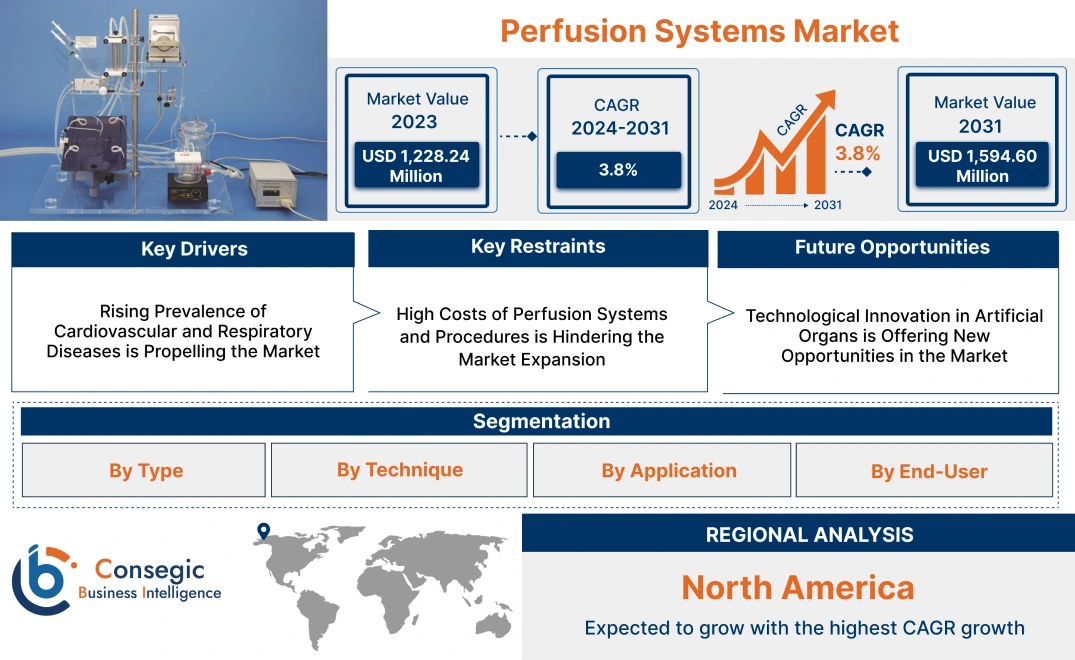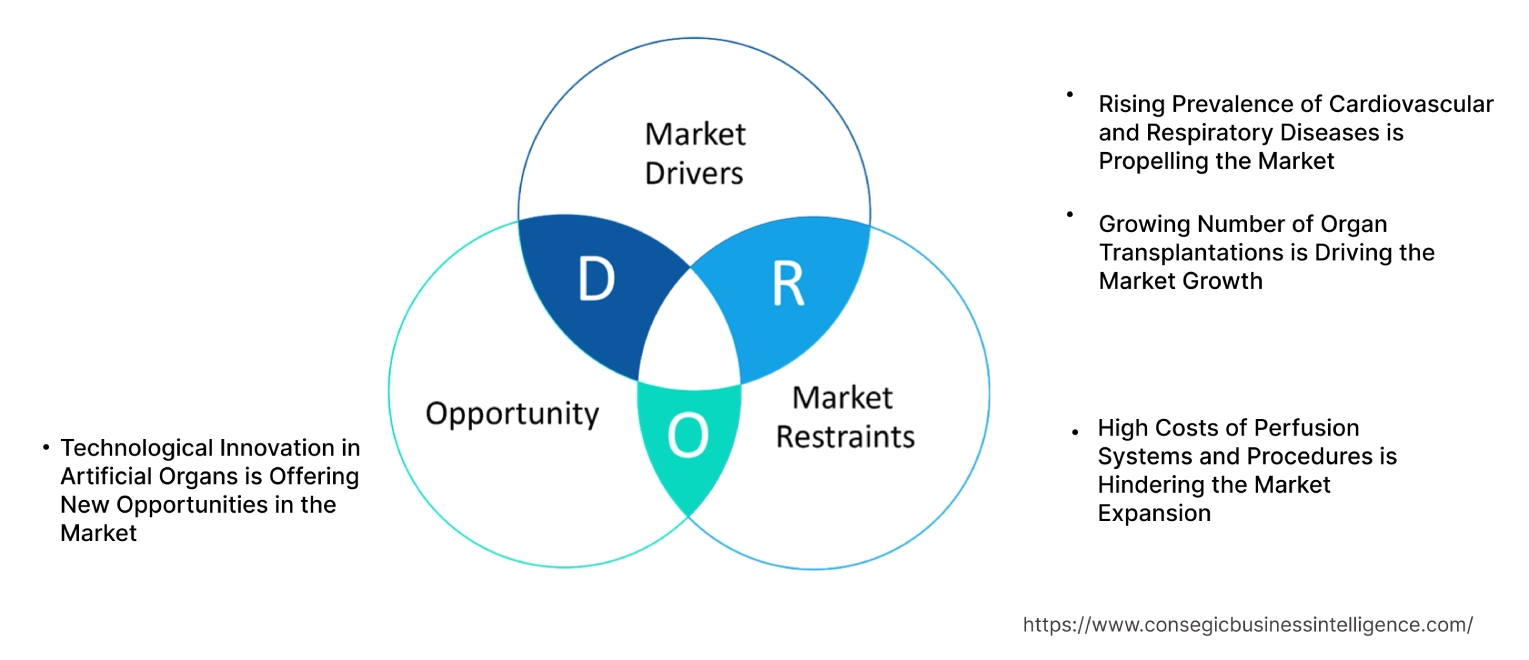Perfusion Systems Market Size:
Perfusion Systems Market size is growing with a CAGR of 3.8% during the forecast period (2024-2031), and the market is projected to be valued at USD 1,594.60 Million by 2031 from USD 1,228.24 Million in 2023.
Perfusion Systems Market Scope & Overview:
Perfusion systems are devices employed in the clinical application in the management of delivering fluids, blood, or other related fluids to; tissues, organs, and other affected areas in an organized manner. Their primary purpose is to supply blood, oxygen, and nutrients to organs and tissues that may require it in situations where the normal circulation in the body is disrupted or stopped. In delicate operations such as those involving the heart and lungs, the systems act as stand-in heart and lungs during the procedure. They develop systems that maintain the flow of blood and oxygen in the body and organs even when one is operating the heart. The systems are used by various professionals in different specialties of medicine or research including cardiothoracic surgeons, transplant surgeons, intensive care practitioners, medical researchers, and pharmacologists.
Perfusion Systems Market Insights:
Perfusion Systems Market Dynamics - (DRO) :
Key Drivers:
Rising Prevalence of Cardiovascular and Respiratory Diseases is Propelling the Market
The increase in the incidence of cardiovascular and respiratory diseases is of critical importance for the application and evolution of perfusion systems. As such clinical conditions increase, the need for complex perfusion technologies and optimal practices also rises. Higher rates of CVS most particularly coronary artery disease, and heart failure, necessitate surgical procedures like CABG, valves, and other cardiac procedures. When undertaking more of such processes, there is always a need for the enhancement of systems that can offer optimum levels of efficiency, precision, and reliability during critical surgeries. Severe cardiovascular and respiratory diseases have increased the adoption of Extracorporeal Membrane Oxygenation (ECMO) and other ECLS technologies. These systems help only those patients who have severe heart/ lung failure by offering mechanical support for an extended period.
Therefore, as these diseases become more prevalent, ongoing advancements and innovations in perfusion technology are becoming essential to addressing the growing demands of healthcare, driving the perfusion systems market growth.
Growing Number of Organ Transplantations is Driving the Market Growth
New developments in perfusion systems are aimed at increasing the amount of time for which organs can be stored outside the recipients' body, which is crucial for increasing rates of organ transplants and increasing the pool of available human donors. More organs are transplanted into the body and therefore there is a need for better preservation solutions. Perfusion technology helps to preserve the quality of the organs throughout the interval between their procurement and transplantation. This technique involves the use of normothermic perfusion, which means that the organ is perfused at normal body temperature as this will help to maintain its physiological status. It is being used more frequently in transplant operations. Today, modern systems of perfusions are designed with monitoring and control abilities that can directly observe the condition of the given organ with the help of such factors as temperature, level of oxygen, and pressure in the perfusion loop.
- In September 2024, according to the transplantation reports innovations in perfusion machine types, preservation solutions, and preservation solution additives have considerably increased the capacity to use organs that were previously considered unsuitable.
Therefore, the growing number of organ transplantations significantly impacts perfusion technology, driving advancements that enhance organ preservation, improve patient outcomes, and address the increasing need for effective transplant solutions, boosting the perfusion systems market demand.
Key Restraints :
High Costs of Perfusion Systems and Procedures is Hindering the Market Expansion
Procedures related to perfusion systems and procedures pose a great challenge to healthcare instituted due to the high costs they entail. Current systems are quite complicated and include various components such as pumps, oxygenators, and monitoring devices. The high technology level of such devices makes their cost higher thanks to the material, manufacturing accuracy, and research and development. Percutaneous cardiopulmonary support systems are made of components such as tubings, filters, and oxygenators that are normally dissemble and disposed. These are those materials that are used in the process of treatment and are useful for every procedure and, therefore, contribute to the cost of treatment. Maintenance of the systems is another important aspect that is an added expense that comes with time and cost.
Therefore, as the healthcare industry evolves, finding solutions to make systems more cost-effective and accessible will be crucial in driving broader adoption of these systems in the market, hindering the perfusion systems market demand.
Future Opportunities :
Technological Innovation in Artificial Organs is Offering New Opportunities in the Market
Surgical and perfusion technology in artificial organs offers a promising development prospect to enhance medical treatment and the quality of patient care. The progression of bioengineering enables the creation of more complex artificial organs, similar to those found in the body naturally. These encompass development in the materials used, design, and the way the tool interfaces with the body's biological processes. Tissue engineering and stem cell technology work to develop new organs through the use of the patient's cells and save problems associated with receptor rejection and organ shortage. Subsequent generations of perfusion systems will demonstrate improved basic and derived real-time analytics, involving multiple sophisticated sensors and algorithms for comprehensive physiological monitoring with appropriate perfusion adjustments.
- In August 2023, Ventricular Assist Devices (VADs), also referred to as artificial hearts, are mechanical devices that help a failing heart pump or temporarily replace it while it seeks a suitable donor heart. These devices provide hope to people who cannot endure fast cardiac transplants.
Therefore, as per the market trends analysis, the technological innovations in these fields are expected to lead to more effective, personalized, and accessible solutions for organ transplantation and support, creating lucrative perfusion systems market opportunities.
Perfusion Systems Market Segmental Analysis :
By Type:
Based on type the market is segmented into Cardiopulmonary Perfusion Systems, Ex Vivo Organ Perfusion Systems, and Cell Perfusion Systems.
Trends in the Type:
- The integration of perfusion systems with advanced monitoring and automation technologies improves patient outcomes and increases the appeal of these systems.
- The advancement of perfusion systems with bioreactor technology allows for better metabolic support and evaluation of organ function before transplantation.
The cardiopulmonary perfusion systems application accounted for the largest revenue of the total perfusion systems market share in 2023.
- Cardiopulmonary perfusion systems are vital during open-heart surgeries, providing oxygenation and circulation when the heart is stopped. This is crucial for procedures such as coronary artery bypass grafting (CABG) and heart valve repair/replacement.
- Continuous innovations in cardiopulmonary perfusion technologies, such as improved oxygenators, pumps, and monitoring systems, enhance the efficiency and effectiveness of these systems, driving adoption.
- The expansion of cardiac surgical programs in hospitals and surgical centers boosts the need for these systems.
- For instance, cardiovascular perfusionists are in charge of operating extracorporeal circulation equipment, such as the heart-lung machine, during open-heart surgery or any other medical procedure that requires artificially supporting or temporarily replacing a patient's circulatory or respiratory function.
- Thus, the cardiopulmonary segment accounted for the largest revenue due to its essential role in cardiac surgery, the increasing prevalence of cardiovascular diseases, and ongoing technological advancements, driving the perfusion systems market growth.
The ex vivo organ perfusion systems segment is anticipated to register the fastest CAGR during the forecast period.
- Ex vivo organ perfusion systems enable longer preservation times, which increases the pool of viable organs for transplantation and improves outcomes for recipients.
- Ongoing clinical trials demonstrating the benefits of ex vivo organ perfusion in various transplant scenarios are driving its adoption in clinical settings.
- The growth of specialized transplant centers and investment in organ transplantation infrastructure drive demand for ex vivo organ systems.
- For instance, the ex vivo MP circuit consists of a humidified organ chamber, perfusion solution, reservoir for perfusion solution collection, oxygenator, and optional leukocyte filter (added when whole blood is used as the perfusion solution) connected via sterile tubing.
- Thus, due to advancements in organ preservation, the growing need for organ transplantation, and ongoing technological innovations the segment is growing, boosting the perfusion systems market trends.
By Technique:
Based on technique the market is segmented into Hypothermic Perfusion, Normothermic Perfusion, and Isolated Limb Perfusion.
Trends in the Technique:
- Enhanced monitoring capabilities during hypothermic perfusion help optimize organ preservation, leading to greater clinical acceptance and use.
- The ability to monitor organ function in real-time during normothermic perfusion allows for better decision-making and optimization of transplantation outcomes.
The hypothermic perfusion application accounted for the largest revenue share of 36.75% in 2023.
- Hypothermic perfusion is essential for preserving donor organs during transportation and storage. By cooling the organs, metabolic rates are reduced, which extends their viability and function until transplantation.
- Utilizing hypothermic perfusion minimizes ischemic damage to organs, leading to better outcomes post-transplantation. This effectiveness is a significant driver of revenue as healthcare providers prioritize techniques that improve survival rates.
- More healthcare facilities are establishing or expanding organ transplant programs, which directly boosts the need for hypothermic perfusion technologies.
- For instance, according to traditional "static cold storage" in an icebox, hypothermic machine perfusion reduces the rate of delayed transplant kidney function, enhances the longevity of the transplanted kidney, and is cost-effective in the United States and Europe.
- Thus, the hypothermic perfusion application accounted for the largest revenue in the market due to its essential role in organ preservation, improved patient outcomes, and ongoing technological advancements, boosting the perfusion systems market trends.
The normothermic perfusion segment is anticipated to register the fastest CAGR during the forecast period.
- Normothermic perfusion maintains organs at physiological temperatures, which helps preserve cellular metabolism and function. This can lead to improved organ viability compared to traditional cold storage methods.
- Innovations in perfusion technology, such as improved normothermic perfusion machines and preservation solutions, are enhancing the efficacy and usability of these systems.
- Normothermic perfusion potentially reduces the incidence of complications associated with organ transplants, enhancing patient outcomes and encouraging healthcare providers to adopt this technology.
- For instance, faced with a dearth of organ donors, a novel procedure known as abdominal normothermic regional perfusion was created. This procedure restores blood flow to organs following circulatory death, retaining their quality.
- Thus, the normothermic perfusion segment is expected to register the fastest due to its advantages in organ preservation, increasing adoption in clinical practice, and ongoing technological innovations, creating perfusion systems market opportunities.
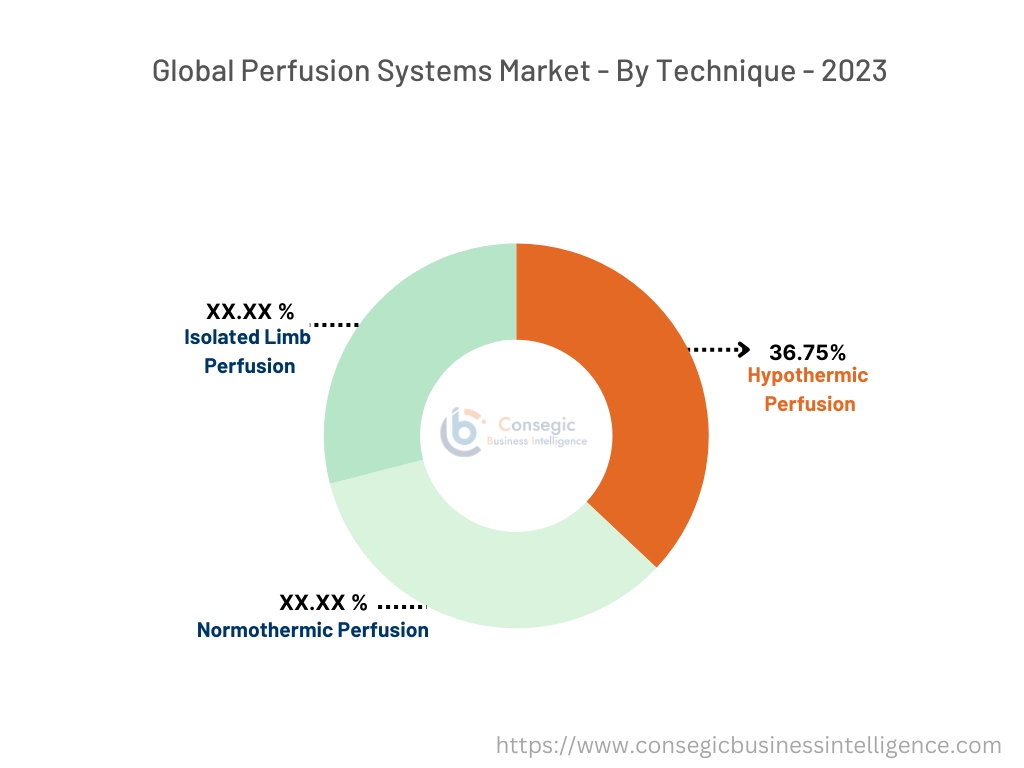
By Application:
Based on application the market is segmented into Organ Transplantation, Cardiac Surgery, Cancer Treatment, Lung Transplantation, and Others.
Trends in the Application:
- Advances in surgical techniques and post-transplant care have increased the success rates of organ transplants, boosting the need for advanced perfusion systems.
- The integration of perfusion systems with advanced diagnostic tools and imaging technologies supports precision oncology, enhancing treatment efficacy and patient outcomes.
The organ transplantation segment accounted for the largest revenue of the overall perfusion systems market share in 2023.
- The growing prevalence of conditions that lead to organ failure, such as diabetes, hypertension, and cardiovascular diseases, drives the need for organ transplants and the associated perfusion systems.
- Advanced systems improve organ preservation and function, which directly impacts the success rates of transplantation procedures and patient outcomes.
- Ongoing research and clinical trials focusing on organ transplantation and perfusion technology advancements contribute to the development and uptake of new systems, impacting revenue in this application area.
- For instance, in the United States, some organ donor recovery centers are handled by Organ Procurement Organizations (OPOs) in collaboration with local transplant centers. These centers are intended to simplify specialized resources, such as staff and facilities, needed for donor maintenance and organ retrieval for transplantation.
- Thus, as the need for organ transplants continues to grow and technology advances, the organ transplantation segment is expected to maintain its significant contribution to the perfusion systems market expansion.
The cancer treatment segment is anticipated to register the fastest CAGR during the forecast period.
- Precision oncology involves customizing cancer treatment based on the genetic, environmental, and lifestyle factors of each patient. Perfusion systems play a critical role in supporting these personalized treatment protocols, driving demand for advanced technologies.
- The development of targeted therapies and immunotherapies for cancer has expanded the use of perfusion systems. These therapies often require sophisticated perfusion techniques to deliver drugs effectively and manage treatment side effects.
- The growing number of clinical trials focused on novel cancer therapies and treatments involves the use of advanced systems, contributing to the market.
- For instance, transcatheter arterial chemoembolization (TACE) is a localized perfusion therapy in which surgeons limit the tumor's blood supply while simultaneously delivering a large dosage of chemotherapy to the cancer.
- Thus, technological innovations, improved patient outcomes, and expanding healthcare infrastructure further contribute to the rapid growth of this segment.
By End-User:
Based on end-user the market is segmented into Hospitals, Organ Transplant Centres, Research Institutes, and Specialty Clinics.
Trends in the End-User:
- Integration with digital health solutions and real-time monitoring systems has enhanced the functionality of perfusion systems, making them more appealing to hospitals.
- The integration of perfusion systems with emerging technologies such as artificial intelligence (AI) and machine learning for data analysis and optimization is driving innovation in research institutes.
The hospitals segment accounted for the largest revenue share in the year 2023.
- Hospitals, particularly those with specialized cardiac care units, are major users of perfusion systems. These systems are crucial for heart surgeries, such as coronary artery bypass grafting (CABG) and heart valve replacements, where systems are used to manage blood circulation and oxygenation.
- Hospitals have dedicated departments and specialized teams for cardiac surgery and critical care, which increases the demand for sophisticated systems.
- Advances in perfusion technology, including more efficient and safer systems, have driven hospitals to upgrade their equipment, contributing to increased revenue in this segment.
- For instance, Rainbow Hospitals in Bengaluru is well-known for providing excellent pediatric ventilation/perfusion scan services.
- Thus, hospitals accounted for the largest revenue in the market due to their high utilization of advanced technologies, the volume of procedures they handle, and their investment in cutting-edge medical equipment.
The research institutes segment is anticipated to register the fastest CAGR during the forecast period.
- Research institutes play a crucial role in developing and testing new perfusion technologies and methodologies. Their focus on innovation and addressing unmet clinical needs drives the need for advanced systems.
- Emerging research areas such as Regenerative Medicine, tissue engineering, and personalized medicine are creating new opportunities for perfusion system applications, driving growth in research institutions.
- There is growing investment from government agencies, private organizations, and international bodies in medical research. These funds are often allocated to research institutes for the development of cutting-edge medical technologies, including perfusion systems.
- Thus, as per the segmental trends analysis, the segment's progress is supported by rising research activities, expansion of research facilities, and industry-academia collaborations, with continued growth expected as research and innovation in the medical field advance.
Regional Analysis:
The regions covered are North America, Europe, Asia Pacific, the Middle East and Africa, and Latin America.
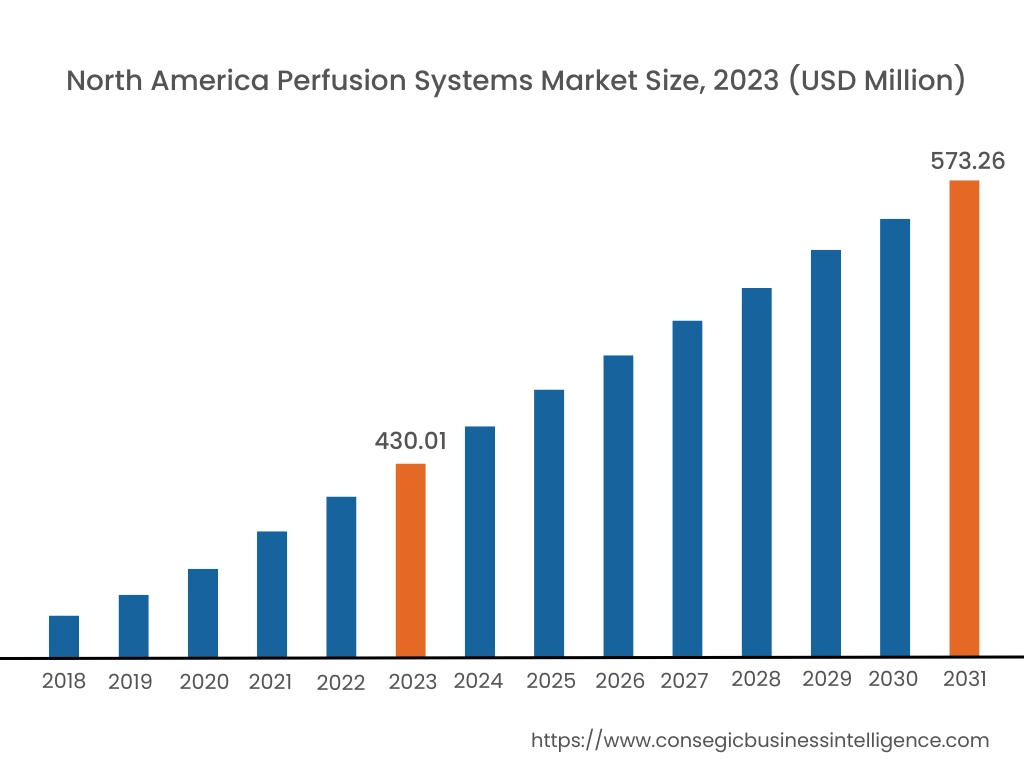
In 2023, North America accounted for the highest market share at 35.01% and was valued at USD 430.01 Million, and is expected to reach USD 573.26 Million in 2031. In North America, the U.S. accounted for the highest market share of 67.11% during the base year of 2023. As per the perfusion systems market analysis, in North America, these systems are crucial components of medical care, particularly in the fields of cardiac surgery, organ transplantation, and critical care. The region is known for its advanced healthcare infrastructure, innovative research, and high adoption of cutting-edge medical technologies. They utilize some of the most advanced systems available, including high-performance heart-lung machines, ECMO (Extracorporeal Membrane Oxygenation) devices, and advanced organ preservation systems.
- In September 2024, Inspira Technologies OXY B.H.N. Ltd., a medical technology business aiming to replace mechanical ventilators, received additional US patent approval for their VORTX™ circling blood oxygenation delivery system.
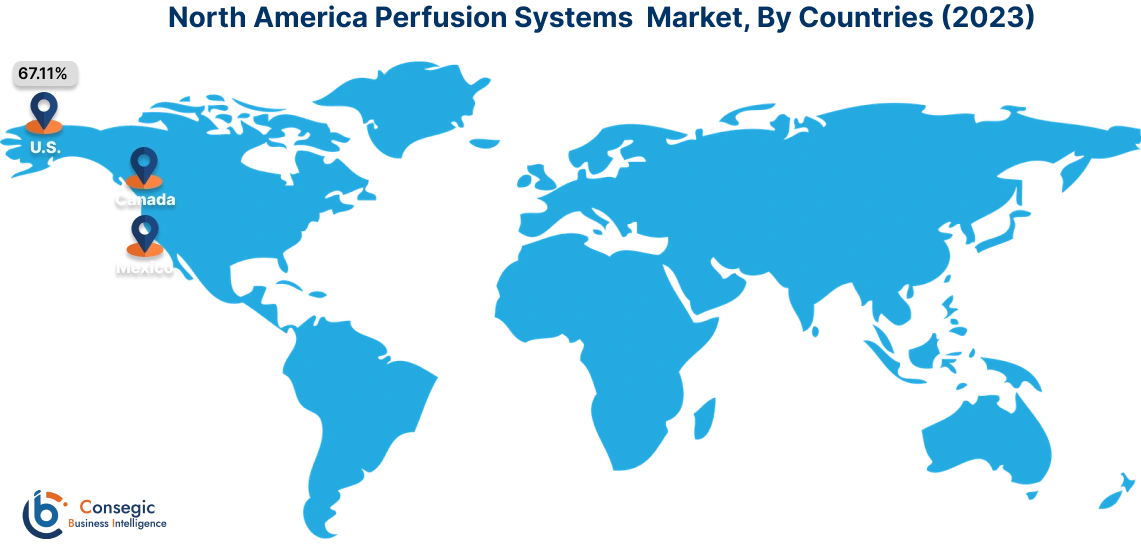
Asia Pacific is expected to witness the fastest CAGR over the forecast period of 4.4% during 2024-2031. Asia-Pacific region experiences rapid urbanization and economic growth, there is a rising prevalence of chronic diseases such as cardiovascular and respiratory conditions, which drives the demand for advanced perfusion technologies. Countries like China, India, Japan, and South Korea are investing heavily in healthcare infrastructure, including advanced medical technologies such as perfusion systems, to meet the growing needs of their populations.
- In 2024, Terumo Cardiovascular develops, manufactures, and distributes medical devices for cardiac and vascular surgery, with a focus on cardiopulmonary bypass, intraoperative monitoring, and vascular grafting. This covers a complete range of perfusion products, endoscopic vascular harvesting equipment, and surgical stabilizing products.
The perfusion systems market analysis shows that European countries are known for their advanced healthcare systems and high-quality medical equipment, including sophisticated systems used in cardiac surgeries and organ transplants. The Middle East and Africa region is influenced by a combination of emerging healthcare needs, varying levels of technological advancement, and diverse healthcare infrastructures. This region encompasses a broad range of economic and healthcare conditions, impacting the adoption and development of advanced perfusion technologies. Latin America is experiencing development in healthcare infrastructure and technology, but there are significant challenges and opportunities specific to perfusion systems. Wealthier countries like Brazil, Mexico, and Chile are seeing more widespread use of advanced systems, while others are still lagging.
Top Key Players & Market Share Insights:
The perfusion systems market is highly competitive with major players providing products to the national and international markets. Key players are adopting several strategies in research and development (R&D), product innovation, and end-user launches to hold a strong position in the global perfusion systems market. Key players in the perfusion systems industry include –
- Medtronic plc. (Ireland)
- Terumo Corporation (Japan)
- XENIOS AG Company (Germany)
- Fresenius Medical Care Ltd. (Germany)
- Siemens Healthineers AG (Germany)
- Getinge AB (Sweden)
- LivaNova PLC (UK)
- Abbott Laboratories (USA)
- Repligen Corporation (USA)
- Merck KGaA (Germany)
Recent Industry Developments :
Merges and Acquisitions:
- In January 2024, Comprehensive Care Services (CCS) acquired German-based Life Systems, making it the world's largest perfusion provider. This move brings together two perfusion care experts, providing global access to high-quality patient care.
Product Launch:
- In January 2024, Inspira plans to launch and target a single-use disposable blood oxygenation kit for the disposable perfusion market. The Kit, which is expected to be submitted for US Food and Drug Administration (FDA) approval in 2025, is a single-use product meant to improve blood oxygenation and carbon dioxide removal.
Product Enhancement:
- In 2024, V controller optimization, online process analytics, and S.U.B. scalability analysis for perfusion applications ranging from 50L pilot to 500L production scale working volumes.
Perfusion Systems Market Report Insights :
| Report Attributes | Report Details |
| Study Timeline | 2018-2031 |
| Market Size in 2031 | USD 1,594.60 Million |
| CAGR (2024-2031) | 3.8% |
| By Type |
|
| By Technique |
|
| By Application |
|
| By End-User |
|
| By Region |
|
| Key Players |
|
| North America | U.S. Canada Mexico |
| Europe | U.K. Germany France Spain Italy Russia Benelux Rest of Europe |
| APAC | China South Korea Japan India Australia ASEAN Rest of Asia-Pacific |
| Middle East and Africa | GCC Turkey South Africa Rest of MEA |
| LATAM | Brazil Argentina Chile Rest of LATAM |
| Report Coverage |
|
Key Questions Answered in the Report
How big is the Perfusion Systems Market? +
Perfusion Systems Market size is growing with a CAGR of 3.8% during the forecast period (2024-2031), and the market is projected to be valued at USD 1,594.60 Million by 2031 from USD 1,228.24 Million in 2023.
Which is the fastest-growing region in the perfusion Systems market? +
The fastest-growing region in the perfusion systems market is Asia Pacific.
What specific segmentation details are covered in the perfusion systems market report? +
The specific segments that are covered in the perfusion systems market are type, technique, application, and end-user.
Who are the major players in the perfusion systems market? +
The major players in the perfusion systems market are Medtronic plc (Ireland), Terumo Corporation (Japan), Getinge AB (Sweden), LivaNova PLC (UK), XENIOS AG Company (Germany), Fresenius Medical Care Ltd. (Germany), Siemens Healthineers AG (Germany), Abbott Laboratories (USA), Repligen Corporation (USA), and Merck KGaA (Germany).
